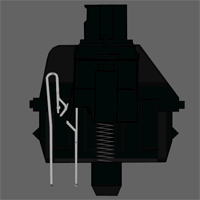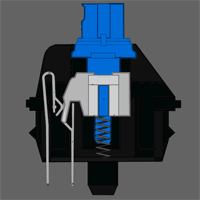Mechanical Keyboard FAQs Frequently asked questions about mechanical keyboards.
What's the difference between the switches?
Introduction - A Switch is Not "Just a Switch"
Many people ask for recommendations about switches without knowing exactly what they are looking for, but instead only with an idea of what their needs are. Fortunately, this is not always a problem because most mechanical switches will always feel nicer than rubber domes. However, the final choice is very important because a switch is not just a switch; it is the heart of what makes your keyboard have its feel and your personal tastes can make or break a keyboard for your uses. If you don't like the switch when you type on it, most likely, you won't ever like the keyboard.
Switches are generally rated by force using the weight measurement of Grams (g). Although force is more accurately described using Centinewtons (cN) However, 1g of weight applies about 1cN of downward force, so we can use "55g" when describing a 55cN-rated switch because that is sometimes easier to understand. For this fact; we'll use Grams as a measurement of force; though either term is correct.
For perspective, it would be wise to remember that your average rubber dome keyboard requires between 55g and 60g of force to actuate.
Cherry MX Black Switches

Type: Linear Switch
Link: Datasheet
Tactile: No
Clicky: No
Actuation Force: 60g (40g-80g overall) (Force Diagram)
Key Travel: 2mm to actuation, 4mm to bottom
Cherry MX-Black switches are linear (non-tactile) switches, these are considered one of the best switch types for gaming. When gaming, having a tactile bump does absolutely nothing because you're going to be bottoming out anyway. So these give you a very smooth feel. The actuation and release points are at the exact same position as well. So games that require a lot of double tapping become easier than on any other keyswitch. However, most people don't enjoy typing on them that much do in part, to their linear nature.Cherry MX Brown Switches
If you're a person who tends to hit a wrong key every so often while gaming, these will be beneficial in that the high actuation force will help prevent many of those accidental presses.

Type: Tactile Switch
Link: Datasheet
Tactile: Yes
Clicky: No
Actuation Force: 45g (55g Peak Force) (Force Diagram)
Key Travel: 2mm to actuation, 4mm to bottom
Cherry MX Brown switches are considered a middle ground between typing and "gaming" switches. They have a light, tactile feel half way through the key press that lets you know the switch has activated. This gives you an indication of what you can release the switch. The switch is considered a middle ground because the reset point & actuation point are close enough together than you can "float" at that point, enabling you to double tap faster.Cherry MX Blue Switches
As a note: this switch actually has a peak force of 55G, it is 45G at the point of actuation. This is due to the design of the Cherry switch itself.

Type: Tactile & Clicky Switch
Link: Datasheet
Tactile: Yes, precise
Clicky: Yes
Actuation Force: 50g (60g Peak Force) (Force Diagram)
Key Travel: 2mm to actuation, 4mm to bottom
Cherry MX Blue switches are the best cherry switch for typing. The tactile bump can easily be felt, and the resistance is similar to your average keyboard.Cherry MX Clear Switches
Although many people find them just fine for gaming, some don't like the fact that the release point is above the actuation point. This can cause some trouble with double-tapping. This is usually the case with someone who has experienced other mechanical switches before hand.
As a note: this switch actually has a peak force of 60g, it is 50g at the point of actuation. This is due to the design of the Cherry switch itself.

Type: Tactile Switch
Link: Datasheet
Tactile: Yes
Clicky: No
Actuation Force: 55g (65G peak force) (Force Diagram)
Key Travel: 2mm to actuation, 4mm to bottom
Cherry MX Clear switches have often been called "stiffer browns" though some users note that they have more of a tactile feel than browns do. This really can be a subjective topic, though this is another switch that could be considered "ballanced." The force required is comparable to most rubber dome keyboards, with a nice tactile feedback to tell you the key has actuated. These switches are harder to find on keyboards.Cherry MX Red Switches
As a note: this switch actually has a peak force of 65g, it is 55g at the point of actuation. This is due to the design of the Cherry switch itself.

Type: Linear Switch
Link: Datasheet
Tactile: No
Clicky: No
Actuation Force: 45g (Force Diagram)
Key Travel: 2mm to actuation, 4mm to bottom
Cherry MX-Red's are another switch that can be considered a "gaming" switch. It's essentially a lighter version of the MX Black, requiring less force to actuate. Some people do not find this switch that good for typing or gaming because it is so light, but others rave for this fact. Light or Stiff is always a matter of preference. This switch was hard to find; and was reported as EOL, but it is still in limited production with a higher than average MOQ leading to higher cost to board makers. Marketed with high demand, boards with this switch are becoming more common, but are generally more expensive as well.Buckling Spring Keyswitches:

Type: Tactile & Clicky Mechanical Switch
Link: Patent
Tactile: Yes, very precise
Clicky: Yes, loud
Actuation Force: 65g-70g (Force Diagram)
Key Travel: 2.3mm to actuation, 3.7mm to bottom
Buckling springs are pretty straightforward once you see them in action. After pushing the key down a certain distance the spring buckles under pressure, causing the hammer at the bottom to hit a membrane sheet and create an electrical contact. The buckling of the spring also provides tactile feedback and a satisfying click as it hits the shaft wall. And you might also notice through the force diagrams that this is the only mechanical switch where the tactile and audible feedback correspond to the exact moment the switch actuates.Black Alps

Type: Tactile Mechanical Switch
Tactile: Yes
Clicky: No
Actuation Force: Simplified 60g, Complicated 70g (Force Diagram)
Key Travel: 3.5mm
Black Alps are one of the two most common Alps switch types. Many people do not like these switches due to the fact that they are stiff, bottom out hard, and tend to develop friction in the travel as they wear. Nonetheless, they are an improvement over most rubber dome keyboards.White Alps
There are two different types of Black Alps switch - an older type known as the "Complicated" due to the large number of parts in the switch, and a newer type known as the "Simplified", which was manufactured by Alps and some other companies. Complicated switches are common in many older keyboards, particularly the Dell AT101W, which is a very common mechanical keyboard from the 1990s.
The most well known Simplified Black switch is made by a company called Fukka, and was used in the ABS M1. The Fukka switch has less resistance, but many claim that it provides less solid tactility than the complicated switch.

Type: Clicky & Tactile Mechanical Switche
Tactile: Yes
Clicky: Yes
Actuation Force: 60g-70g (Force Diagram)
Key Travel: 3.5mm
White Alps are one of the most common Alps switch types. These are far more popular than the Black switches due to more pronounced tactility, and the lower force requirements of some versions. Like the Black Alps, White Alps are much easier to bottom out on compared with other mechanical keyswitch designs.Topre Key Switches:
As with the Black switch. there are Complicated and Simplified White switches. The two most popular Simplified White switches are the Fukka and the XM. The XM is almost universally considered to be a terrible switch, it was used on some older Filco Zero models, and some vintage keyboards. The Fukka switch is quite popular, and some people prefer them over the Complicated switch. It is used on some current production Alps keyboards such as current production Filco Zeros, Matias keyboards and some others. Complicated White switches were used on some well made keyboards from the 90s such as the Northgate and Focus keyboards.
There are also a variety of White Alps-like switches of varying quality. Some, like the SMK Monterey, are considered very pleasant to type on..

Type: Tactile Capacitive Switch
Link: Patent
Tactile: Yes
Clicky: No
Actuation Force: 30g, 35g, 45g, 55g depending on model (Force Diagram)
Key Travel: 4mm
Topre switches are somewhat of a hybrid switch, and are capacitive by nature. The Topre mechanism uses a spring underneath a rubber dome, and the depression of the spring causes a change in capacitance between the underlying capacitor pads. With this change in capacitance; the switch activates.
Topre Switches are considered some of the finest switches available, as they offer a very enjoyable typing experience with a quieter experience compared to a Cherry MX, Alps, or Buckling Spring switch. The reason is Topre switches have the smoothest force gradient even compared to Linear switches like MX-Reds and MX-Blacks.





